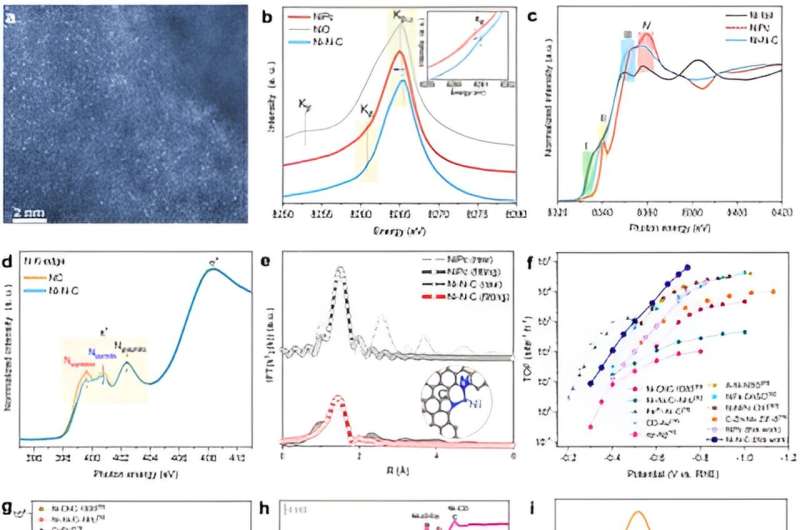This article has been reviewed according to Science X's editorial process and policies. Editors have highlighted the following attributes while ensuring the content's credibility:
fact-checked
peer-reviewed publication
proofread
Developing new catalysts for carbon dioxide electroreduction

As a crucial part of Carbon Capture, Utilization, and Storage (CCUS) technology, CO2 reduction reaction (CO2RR) to carbon-based fuels and chemicals presents broad application prospects in renewable energy storage and CO2 negative emission.
Recently, a team led by Prof. Song Li and Associate Researcher He Qun from the National Synchrotron Radiation Laboratory of the University of Science and Technology of China (USTC) of the Chinese Academy of Sciences (CAS) put forth a novel understanding of the mechanism of CO2RR on the nickel (Ni) single-atomic sites. Their study, titled "Asymmetric Dinitrogen-Coordinated Nickel Single-Atomic Sites for Efficient CO2 Electroreduction," was published in Nature Communications.
An ideal CO2RR catalyst requires low overpotential and high current density to products. However, former catalysts either are featured with high cost and low current density, such as gold (Au) and silver (Ag), usually exhibit much higher overpotentials than Au and Ag, such as Fe, Co, or Ni, limiting reaction efficiency.
Therefore, it is imperative to develop overpotential low, high current density, abundant 3d metal-based catalysts to replace precious metal catalysts for CO2RR. To address those challenges, the researchers proposed an asymmetric dinitrogen-coordinated nickel single-atom catalyst (Ni-N-C). By utilizing the unsaturated and asymmetric characteristics of the sites, structural self-optimization during the electrochemical process is achieved, thereby enhancing the intrinsic activity of the sites in CO2RR.
In the study, the team designed and synthesized Ni-N-C featuring dinitrogen coordination (pyridinic and pyrrolic nitrogen) and then utilized it for CO2 electroreduction reactions in neutral and alkaline media. Synchrotron radiation X-ray absorption spectra and emission spectra revealed the local coordination structure of Ni sites in the catalyst. The electrochemical test results showed that the Ni-N-C catalyst could achieve very high electrochemical performance in both neutral (H-type cell) and alkaline (gas diffusion electrode, GDE) electrolytes.
Especially in alkaline conditions, the catalyst could achieve a CO partial current density of 20.1 mA cmgeo-2 at -0.15 V vs. reversible hydrogen electrode (VRHE), Faraday efficiency of over 90% for CO in the potential range of -0.15 to -0.9 VRHE, and high turnover frequency (TOF) of over 274,000 site-1 h-1 at -1.0 VRHE, surpassing most reported catalysts.
This study offers a novel comprehension of the catalyst's role in the CO2 electroreduction reaction and promises to shed new light on future CO2 reduction technologies.
More information: Yuzhu Zhou et al, Asymmetric dinitrogen-coordinated nickel single-atomic sites for efficient CO2 electroreduction, Nature Communications (2023). DOI: 10.1038/s41467-023-39505-2
Journal information: Nature Communications
Provided by University of Science and Technology of China





















